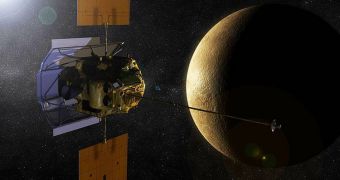The NASA MErcury Surface, Space ENvironment, GEochemistry and Ranging (MESSENGER) mission to the innermost planet in our solar system has been extended by a year, officials at the American space agency announce.
Originally, the space probe was supposed to cease operations in 2012, but officials decided to grant it more time to conduct its studies. The spacecraft launched back in August 2004, aboard a Delta II delivery system.
Before becoming the first vehicle ever to achieve orbital insertion around Mercury, it conducted one flyby of Earth, two flybys around Venus, and three around Mercury. Eventually, it was captured by the fiery world's gravitational pull on March 18, 2011.
MESSENGER was supposed to conduct studies of the planet for a full year, but NASA analyses indicate that the costs of continuing mission funding beyond 2012 are well worth it, considering the scientific return the orbiter is already producing.
At this point, the new mission extension funds operations through March 2013. By that time, if the spacecraft is still operational, another mission extension may yet be considered. However, there are many people who believe it is capable of withstanding the conditions around Mercury for so long.
In a statement released on November 14, Carnegie Institution of Washington (CIW) MESSENGER principal investigator Sean Solomon said that the spacecraft would move in closer to the planet's surface during the extended mission.
“We will spend more time close to the planet than during the primary mission, we'll have a broader range of scientific objectives, and we'll be able to make many more targeted observations with our imaging system and other instruments,” he explains, as quoted by Space.
“Messenger will also be able to view the innermost planet as solar activity continues to increase toward the next maximum in the solar cycle. Mercury's responses to the changes in its environment over that period promise to yield new surprises,” the expert goes on to say.
There are numerous phenomena on Mercury that need answers. One example is determining how long the planet's volcanoes remained active after it first coalesced. Another mystery is how variations in solar radiations change the planet's thin atmosphere.
Even if the probe were to break down tomorrow, scientists will still be satisfied with the 60,000+ photos MESSENGER collected of the planet. The new decision NASA took also allows the science team behind the orbiter to continue analyzing incoming data until at least 2014.

 14 DAY TRIAL //
14 DAY TRIAL //